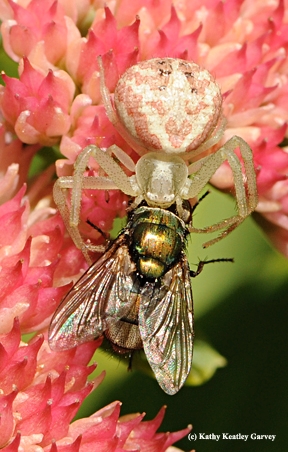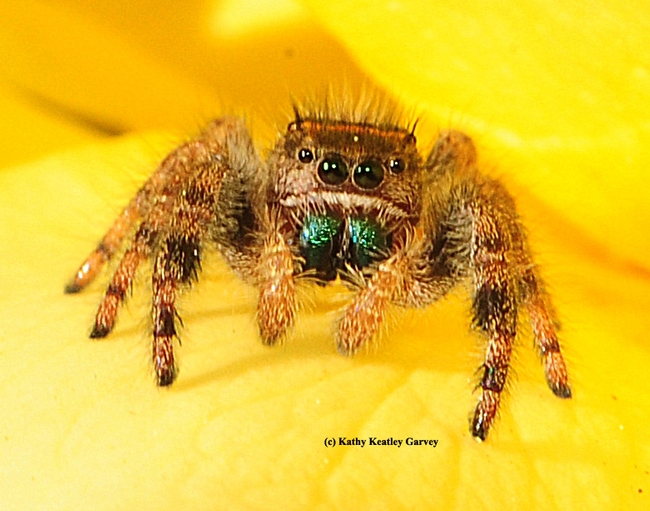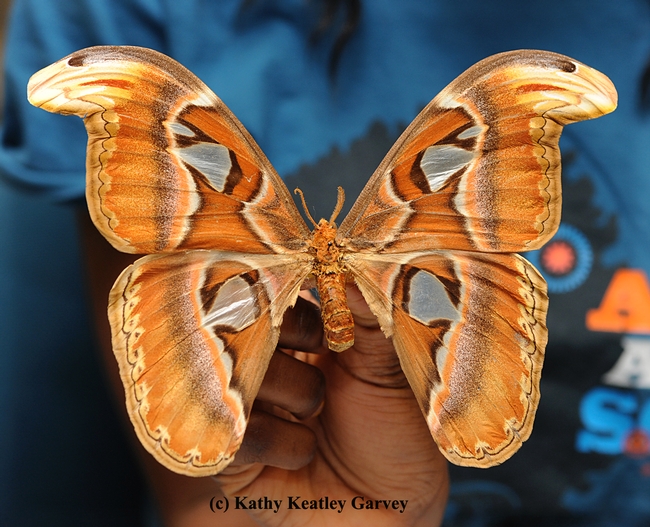- Author: Kathy Keatley Garvey

Neither will J. K. Rowling, author of the wildly popular Harry Potter series of books.
They hate spiders. In fact, by all accounts, they have arachnophobia, an intense fear of spiders that affects some 3.5 to 6.1 percent of the U.S. population.
No wonder the Bohart Museum of Entomology has themed its open house on Saturday, July 26: "Arachnids: Awesome or Awful?"
The event, free and open to the public, takes place from 1 to 4 p.m. at the Bohart Museum, located in Room 1124 of Academic Surge on Crocker Lane, UC Davis campus.
Many locally found spiders, including the black widow, jumping spider and cellar spiders--alive and specimens--will be exhibited. Want to know what the spider is that's dangling from your zinnias or crouched on a sedum or hiding in your woodpile? The Bohart Museum officials will tell you all about them.
Spiders are found throughout the world, except in Antarctica (where Timberlake and Rowling have probably pondered as suitable living quarters.)
A special attraction at the Bohart Museum will be Rosie, a 24-year-old tarantula reared by entomologist/Bohart volunteer Jeff Smith of Sacramento. Visitors are invited to hold it and photograph it.

Children and/or family activities are also planned, said Tabatha Yang, education and outreach coordinator at the Bohart.
Yang said some folks are "creeped out" by spiders while others are eager to see them. The open house will be an informational activity about them, but other insects will be there as well. In addition to its nearly eight million insects founds throughout the world, the Bohart houses live Madagascar hissing cockroaches and walking sticks, which visitors enjoy holding and photographing. A new addition is a Peruvian walking stick with red wings, yellow eyes and a velvety body.
This week is also National Moth Week.
The museum's gift shop, open throughout the year (credit-card purchases are accepted), includes T-shirts, sweatshirts, books, jewelry, insect-collecting equipment and insect-themed candy.
The Bohart Museum, directed by Lynn Kimsey, professor of entomology at UC Davis, houses the seventh largest insect collection in North America. It is also the home of the California Insect Survey, a storehouse of the insect biodiversity. Noted entomologist Richard M. Bohart (1913-2007) founded the museum.
Bohart officials schedule weekend open houses throughout the academic year. The museum's regular hours are from 9 a.m. to noon and 1 to 5 p.m. Mondays through Thursdays. The insect museum is closed to the public on Fridays and on major holidays. Admission is free. More information is available from Tabatha Yang at tabyang@ucdavis.edu or by telephoning (530) 752-0493.


- Author: Kathy Keatley Garvey
Moths.
Mother's Day.
The two go together like a moth to a flame, so why not have "Moth-er's Day?"
And that's exactly what the Bohart Museum of Entomology is doing from 1 to 4 p.m.,Sunday, May 4 in Room 1124 of Academic Surge, Crocker Lane, UC Davis. The open house is free and open to the public.
The Atlas moth (Attacus atlas), the world's largest moth with the greatest wing area of 10 to 12 inches, will be among the insect specimens displayed. The Atlas is found in the tropical and subtropical forests of Southeast Asia--and in the Bohart Museum!
Visitors will see the incredible diversity of moths, and learn the differences between moths and butterflies. "There is far greater diversity among moths than butterflies," said Tabatha Yang, education and outreach coordinator.
Both moths and butterflies are in the order Lepidoptera, which refers to the scales on their wings.
Another large moth on display will be the "bat moth" or "black witch" (Ascalapha odorata), found in Central America, South America, Bahamas and parts of the southwestern United States. In Mexican and Caribbean folklore, it is considered a harbinger of death. The insect played a role in the movie, "Silence of the Lambs" but the name was changed to "Death's-head Hawkmoth."
The white-lined Sphinx moth (Hyles lineata) is another critter you'll see. It flies both at night and during the day and has a wing span length between 2.7 and 3.9 inches. Some folks know it by its nickname, "the hummingbird moth." A member of the Sphingidae family, the white-lined sphinx moth is found throughout most of the United States, plus Mexico, Central America and Canada.
What other kinds of moths will you see on Moth-'ers Day?
- The White Witch (Thysania agrippina), which holds the record for the largest wingspan in an insect (one Brazilian specimen has a wingspan of almost 12 inches). Note that the Atlas has the greater wing area.
- Tomato Hornworm (Manduca quinquemacaulata), what you don't want to see in your garden.
- Sunset Moth (Urania leilus), a colorful day-flying moth often mistaken for a butterfly
- Cosmosoma spp., a genus of clear-winged moths
- Automeris spp., a genus of moths with distinctly large owl-eyes on the hindwings
- Sesiidae, a family of moths mimicking wasps
- Bee-Hawk Moths (Hemaris spp.), a genus of sphinx moths mimicking bumble bees, and sometimes mistaken for hummingbirds
- Moon Moths (Argema spp.), found in Africa and Asia
- Tiger Moths (family Arctiidae), amazing butterfly mimics
- Indian Meal Moths (Plodia interpunctella), also called pantry moths (the caterpillars are grain pests)
The Moth-er's Day event is also a good time to explore the Bohart Museum gift shop for Mother's Day gifts, including jewelry (necklaces, pins and earrings), books and other items suitable for entomology fans.
Visitors can hold live insects such as Madagascar hissing cockroaches, Vietnamese walking sticks, walking leaves and a rose-haired tarantula.
The Bohart Museum, directed by Lynn Kimsey, professor of entomology at UC Davis, was founded in 1946 by the late Richard M. Bohart. Dedicated to teaching, research and service, the museum houses nearly eight million insect specimens collected globally. It boasts the seventh largest insect collection in North America.



- Author: Kathy Keatley Garvey

And maybe give them a hug? Or two? Or three?
Some 3000 third-graders who participated in the annual Solano County Youth Ag Day on March 18 at the Solano County Fairgrounds made a beeline for the bugs at the Bohart Museum of Entomology's hands-on activity.
Future entomologists? Maybe.
The UC Davis-based insect museum, directed by Lynn Kimsey, provided just one of the activities on the Vallejo fairgrounds, where the youngsters visited cows, rabbits and chickens; watched sheep-herding dog demonstrations; participated in 4-H SET (science, engineering and technology) events, and went home knowing that chocolate milk doesn't come from brown cows.
The bugs? Oh, sure, some of the youngsters were initially a little squeamish and squirmish when they saw the Madagascar hissing cockroaches and walking sticks. But the "fear factor" soon vanished as they watched the insects crawl up their arms. The bugs tickled and the youngsters giggled.
Tabatha Yang, the Bohart Museum's education and outreach coordinator, said the youths really enjoyed the "hissers" and "stick insects" and learning more about them. Bohart museum volunteers Maia Lundy, Noah Crockette and Rachael Graham delighted in showing the bugs to the youngsters. A display of bee and butterfly specimens also drew "oohs" and "aahs."
The Bohart Museum, home of nearly eight million insect specimens, plus a live "petting zoo," traditionally provides an educational display at the Solano County Ag Day. The Solano County Fair Association hosts the annual event.
Next up in the Bohart Museum's lineup of educational activities: an open house from 1 to 3 p.m., Saturday, April 12 at its headquarters in Room 1124 of the Academic Surge Building, Crocker Lane. It's part of the campuswide Picnic Day.



- Author: Kathy Keatley Garvey

Among the many activities at their recent "Snuggle Bugs" open house was a "mite/art station." Visitors were given a paper plate and invited to draw a mite, or other parasitic critter, and then attach the plate to an unsuspecting host.
Alex Nguyen, a third-year entomology student at UC Davis, managed to get most of the mites..er plates. Maybe it was because he was wearing a UC Davis Graduate Students' Association t-shirt lettered with "Entomology's Most Wanted." Or maybe the crowd saw him as a virtual parasitic pincushion.
"if you were a honey bee," the Bohart Museum sign at the mite table read, "this plate would be about the size of a varroa mite on you."
The Bohart Museum, directed by Lynn Kimsey, UC Davis professor of entomology, is the home of nearly eight million insect specimens, plus a live "petting zoo" that includes Madasgascar hissing cockroaches, walking sticks, rose-haired tarantula, millipedes and praying mantids. Located in Room 1124of the Academic Surge building on Crocker Lane, the insect museum is open to the public Monday through Thursday throughout the year (except on holidays).
Next event? On Saturday, Jan. 25, the Bohart staff and volunteers will travel to the InsectFest at the World of Wonders (WOW) Museum, Lodi, to showcase their insects.
The Bohart's next weekend "home" event is Saturday, Feb. 8, which is the annual UC Davis Biodiversity Day.
Six biological museums will be included in the campuswide event. You'll see the open collections of the Bohart Museum of Entomology, the Museum of Wildlife and Fish Biology, the Botanical Conservatory, the Center for Plant Diversity, the Anthropology Collections, and the Paleontology Collections.
The Biodiversity Day takes place from noon to 4 p.m. and is an opportunity to see "see carnivorous plants, touch fossils, learn about birds and hold insects," said Tabatha Yang, outreach and education coordinator at the Bohart.
Free and open to the public, it's a family friendly event. See the Bohart for more information and a map.
Insects? Plants? Fossils? Birds? "Bio Day" promises to be educational, informative and entertaining.

- Author: Kathy Keatley Garvey

Bed bugs, lice, ticks, mites, fleas and mosquitoes.
If you want to see and/or learn more about them, attend the Bohart Museum of Entomology's "Snuggle Bugs" open house from 1 to 4 p.m., Sunday, Jan. 12 in Room 1124 of the Academic Surge building on Crocker Lane, UC Davis campus.
It's free and open to the public, and families especially are encouraged to attend, says Tabatha Yang, education and outreach coordinator.
A highlight will be a display of bed bugs reared by Danielle Wishon, a 2013 UC Davis entomology graduate and an affiliate of the Bohart Museum. Wishon. She plans to feed them (her blood) around 2 p.m.
Wishon began rearing her first research colony of bed bugs in October 2012. She's since added a second colony. She's deliberately keeping the colonies small. Total count: around 100.
Wishon, a lab assistant at the California Department of Food and Agriculture since late last summer, said she became interested in bed bugs while studying with UC Davis forensic entomologist Robert Kimsey. Also spurring her interest: the questions asked at the Bohart. "Visitors were bringing in various insects and asking if they were bed bugs," she said. Among the insects: carpet beetles, dog ticks, swallow bugs and bat bugs.
Wishon aims to dispel the myths about bed bugs. There's a lot of misinformation on the Internet, she says. Unlike many insects, "they don't spread diseases."
Wishon maintains her colonies in Briggs Hall, home of the UC Davis Department of Entomology and Nematology. Any escapees? No. She's especially observant with the first instars, which are about one millimeter long.
Wishon is a past president of the UC Davis Entomology Club and recipient of the department’s 2011 Outstanding Undergraduate Student Award.
The Bohart Museum, directed by Lynn Kimsey, professor of entomology at UC Davis and housing nearly eight million specimens, is the seventh largest insect collection in North America. It is also the home of the California Insect Survey, a storehouse of insect biodiversity. Noted entomologist Richard M. Bohart (1913-2007) founded the museum in 1946.
Special attractions at the Bohart include a live "petting zoo," with critters such as Madagascar hissing cockroaches, walking sticks, millipedes, tarantulas and praying mantids. Visitors can also shop at the year-around gift shop (or online) for t-shirts, jewelry, insect nets, posters and books, including the newly published children’s book, “The Story of the Dogface Butterfly,” written by UC Davis doctoral candidate Fran Keller and illustrated (watercolor and ink) by Laine Bauer, a 2012 graduate of UC Davis. The 35-page book also includes photos by naturalist Greg Kareofelas of Davis, a volunteer at the Bohart.
Sunday' open house is just one of the many scheduled weekend open houses held throughout the academic year. Regular hours are from 9 a.m. to noon and from 1 to 5 p.m., Monday through Thursday. The insect museum is closed to the public on Fridays and on major holidays. Admission is free. More information, including information on group tours, is available from Tabatha Yang at tabyang@ucdavis.edu.



